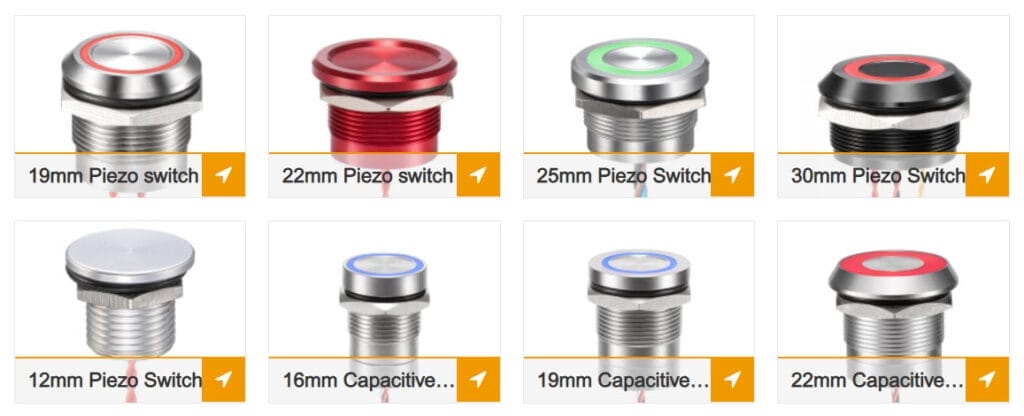In today’s rapidly evolving technological landscape, capacitive switches have gained significant prominence as reliable and durable input devices. From smartphones and tablets to industrial control panels, capacitive switches are ubiquitous, offering a seamless and touch-sensitive interface. While their functionality might appear straightforward, the selection of the right materials plays a pivotal role in determining their performance and longevity. This article delves into the most crucial considerations in material selection for capacitive switches, ensuring that the end product meets the highest standards of performance and durability.
Table of Contents
- Introduction
- Understanding Capacitive Switches
- Role of Materials in Capacitive Switches
- Conductive vs. Non-conductive Materials
- Material Considerations for the Substrate
- Overlay Materials for Capacitive Switches
- Comparing Common Materials
- Factors Impacting Material Selection
- Durability and Environmental Considerations
- Tactile Feedback and Actuation Force
- Customization and Aesthetics
- Manufacturability and Cost
- Testing and Quality Assurance
- Conclusion
- Frequently Asked Questions
Introduction
Capacitive switches have revolutionized the way we interact with various devices. Whether it’s a gentle tap on your smartphone screen or the responsive keys on your microwave oven, capacitive switches have become an integral part of modern technology. However, beneath their sleek exteriors, lies a complex array of materials that dictate their functionality.
Understanding Capacitive Switches
Capacitive switches are touch-sensitive devices that rely on changes in capacitance to detect user input. They consist of several layers, including a substrate and an overlay. When a user touches the overlay, the capacitance between the layers changes, triggering an action or response.
Role of Materials in Capacitive Switches
The choice of materials in capacitive switches is not arbitrary; it has a profound impact on their performance. From ensuring reliable touch detection to withstanding the test of time, the right materials are crucial.
Conductive vs. Non-conductive Materials
Capacitive switches use both conductive and non-conductive materials. The conductive materials, typically used in the electrodes, enable touch detection. Non-conductive materials form the insulating layers that separate the electrodes.
Material Considerations for the Substrate
The substrate is the foundation of the capacitive switch. Factors such as rigidity, thickness, and dielectric constant must be considered when selecting substrate materials. Common choices include glass, plastic, and PCBs.
Comparing Common Materials
The choice of materials in capacitive switches is a critical decision that significantly influences their performance and durability. Let’s delve into a comparison of commonly used materials to provide you with a better understanding of their strengths and weaknesses.
This section will compare commonly used materials in capacitive switches, such as indium tin oxide (ITO), printed silver ink, and various overlay options.
Pros:
- High transparency, making it ideal for touchscreens and displays.
- Excellent electrical conductivity for responsive touch detection.
- Compatibility with a wide range of substrates.
Cons:
- Brittle and prone to cracking.
- Susceptible to wear and abrasion.
- Limited flexibility, which may not be suitable for curved or flexible displays.
Pros:
- Good electrical conductivity and responsiveness.
- Flexibility, making it suitable for curved or flexible surfaces.
- Cost-effective for mass production.
Cons:
- Lower transparency compared to ITO.
- Susceptible to wear and scratching over time.
- May require protective coatings for enhanced durability.
3. Glass
Pros:
- High rigidity and durability.
- Excellent transparency and optical clarity.
- Resistant to wear, scratches, and chemical exposure.
- Ideal for high-end applications and where aesthetics matter.
Cons:
- Lack of flexibility, limiting its use in curved or flexible displays.
- Brittle and may shatter upon impact.
- Heavier compared to plastic or film materials.
4. Plastic
Pros:
- Lightweight and flexible, suitable for curved and flexible surfaces.
- Cost-effective and customizable in terms of color and texture.
- Resistant to impact and shattering.
Cons:
- Lower durability compared to glass, making it more prone to wear and scratches.
- May yellow or degrade over time due to UV exposure.
- Limited optical clarity compared to glass.
5. Specialized Overlay Films
Pros:
- Flexibility for curved and irregular shapes.
- Customizable in terms of appearance, texture, and graphics.
- Can provide enhanced wear resistance with proper coatings.
Cons:
- May require additional layers for optimal electrical conductivity.
- Prone to wear and scratching without protective coatings.
- Variability in quality and performance depending on the manufacturer.
Overlay Materials for Capacitive Switches
The overlay is the topmost layer of a capacitive switch, the one users interact with. Materials like glass, plastic, or even specialized films can be used. The choice depends on the intended application and the desired aesthetics.
Factors Impacting Material Selection
Material selection is influenced by various factors, including the intended application, environmental conditions, and cost considerations. Each application may have unique requirements, demanding a careful balance of factors.
Durability and Environmental Considerations
Capacitive switches must endure various environmental factors, including temperature fluctuations, humidity, and exposure to chemicals. The selected materials should withstand these conditions without compromising functionality.
Tactile Feedback and Actuation Force
The tactile feedback and actuation force are essential considerations, particularly in devices like keyboards. Materials impact the ‘feel’ of a switch and how much force is required to trigger it.
Customization and Aesthetics
For consumer-facing devices, the aesthetics are a crucial aspect. Material selection can influence the appearance, texture, and overall design of the capacitive switch, making it a vital consideration for product designers.
Manufacturability and Cost
Balancing manufacturability and cost is another crucial factor. Some materials may offer excellent performance but be cost-prohibitive for mass production. Finding the right balance is essential.
Testing and Quality Assurance
Material selection isn’t the end of the journey. Rigorous testing and quality assurance processes are necessary to ensure that the chosen materials perform as expected and meet industry standards.
Conclusion
In the realm of capacitive switches, material selection is a nuanced process. It involves a delicate balance of functionality, durability, aesthetics, and cost. The right materials can make the difference between a robust and responsive switch and one that falls short of expectations. By carefully considering the factors mentioned in this article, manufacturers and product designers can ensure that their capacitive switches deliver exceptional performance and user satisfaction.
Frequently Asked Questions
1. What are capacitive switches used for?
Capacitive switches are used in a wide range of applications, from smartphones and tablets to industrial control panels and household appliances.
2. What materials are commonly used in capacitive switches?
Common materials include indium tin oxide (ITO), printed silver ink, glass, plastic, and specialized overlay films.
3. How does material selection impact the lifespan of capacitive switches?
The right materials can enhance the durability and longevity of capacitive switches, ensuring they perform reliably over time.
4. Are capacitive switches suitable for harsh environments?
Yes, with the right material selection, capacitive switches can be designed to withstand harsh environmental conditions.
5. What is the importance of tactile feedback in capacitive switches?
Tactile feedback influences the user experience, providing a satisfying ‘click’ or ‘touch’ sensation, which is crucial for user satisfaction.
Send your inquiry now
All Langier News:
Read Moreelectronica 2024 Hall-Stand No.: A2 160 November 12-15, 2024 Tr...

 English
English 简体中文
简体中文




